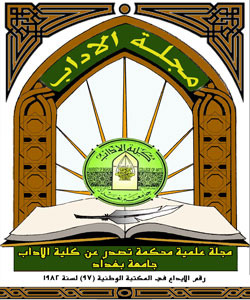Place and Conflicting Powers in David Greig’s The Architect
DOI:
https://doi.org/10.31973/aj.v2i144.4066الكلمات المفتاحية:
place، conflicting powers، old and new generation، imagination and realityالملخص
There is a reciprocal connection between a place and its inhabitants who attempt to shape it according to their aspirations and needs. This may result in the emergence of conflicting powers that struggle to control the place and decide its policies that, in return, affect people's lives and careers. This paper focuses on David Greig’s The Architect. The play is concerned with the conflict between Leo Black, an architect who is commissioned by the government to design Eden Court, and the tenants of the building who are represented by Sheena Mackie. The setting symbolizes Scotland and Sheena Mackie and the tenants represent the new generation in Scotland and their aspiration for change. The play will be telescoped through the lense of the Thirdspace theory by the American theorist Edward Soja (1940-2015). According to his theory, space is classified into three levels: the firstspace which represents reality as it is, the secondspace that embraces people's perspectives about the place they occupy, and the thirdspace which combines both of the above-mentioned spaces. The purpose of the study is to show how a place can be determined by the power that succeeds in envisioning a third space combining first and second spaces.
التنزيلات
المراجع
Agnew, John A. (1987). Place Politics: The Geographical Meditation of State and Society. Allen& Unwin Inc.
Agnew, John. A., et al. (2003). “Place and Politics: the geographical meditation of state and society”. Progress in Human Geography, vol. 27, no.5, pp.605-614. Doi: 10.1191/0309132503ph451xx.
Basuki, Ribut. (2002). ‘Brecht’s Epic Theatre as a Modern Avant-Garde and Its Influence on Postmodern Theatre/Drama’. K@ta: A Biannual Publication on the Study of Language and Literature, vol.4, no.2, Pp. 135-147.
Glendinning, Miles and Stefan Muthesuis. (1994). Tower Block: Modern Public Housing in England, Scotland, Wales, and Northern Ireland. New Haven: Yale University Press for The Paul Mellon Centre for Studies in British Art.
Greig, David. (2002). Play 1: Europe, The Architect, The Cosmonaut’s Last Message to the Woman He Once Loved in the Former Soviet Union. London: Methuen.
Harvey, David. (2000). Spaces of Hope. Edinburgh University Press.
Jameson, Fredric. (2013). Postmodernism, or, The Cultural Logic of Late Capitalism. New York, USA: Duke University Press. https://doi.org/10.1515/9780822378419
Martin, Sara. (2014). “A Demolition Job :Scottish Masculinity and the Failure of the Utopian Tower Block in David Greig’s Play The Architect and Andrew O’Hagan’s Novel Our Fathers”. Universitat Autònoma de Barcelona. https://www.semanticscholar.org
Modern Scotland. (2014, September 19). BBC History. https://www.bbc.co.uk/history/scottishhistory/modern/intro_modern3.shtml
Accessed 14 Aug. 2022.
Nur, Esma. (2021). Space and Architecture. Eurasian Journal of English Language and Literature, vol. 3(1), 245- 261. https://dergipark.org.tr/en/pub/jel
Qian, Junxi. (2019). Place Politics. In Antony M. Orum (ed.), The Wiley-Blackwell Encyclopedia of Urban and Regional Studies ( pp.1479-1483). Wiley Blackwell,
Richardson, Bill. (2015). Spatiality and Symbolic Expression. On the Links between Place and Culture. Palgrave Macmillan, United States. St. Martin’s Press, New York.
Soja, E. W. (1996). Thirdspace. Cambridge, MA: Blackwell.
Tally, Robert. T. (2013). Spatiality. Taylor & Francis Group, Routledge.
Young, Hugo. (2022). Margaret Thatcher. Encyclopedia Britannica (April 2022 ed.). https://www.britannica.com/biography/Margaret-Thatcher. Accessed 21 Apr. 2022.
التنزيلات
منشور
إصدار
القسم
الرخصة

هذا العمل مرخص بموجب Creative Commons Attribution 4.0 International License.
:حقوق الطبع والنشر والترخيص
بالنسبة لجميع البحوث المنشورة في مجلة الآداب، يحتفظ الباحثون بحقوق النشر. يتم ترخيص البحوث بموجب ترخيص Creative Commons CC BY 4.0 المفتوح ، مما يعني أنه يجوز لأي شخص تنزيل البحث وقراءته مجانًا. بالإضافة إلى ذلك ، يجوز إعادة استخدام البحث واقتباسه شريطة أن يتم الاستشهاد المصدر المنشور الأصلي. تتيح هذه الشروط الاستخدام الأقصى لعمل الباحث وعرضه.
:إعادة إنتاج البحوث المنشورة من الناشرين الآخرين
من الضروري للغاية أن يحصل الباحثون على إذن لإعادة إنتاج أي بحث منشورة (أشكال أو مخططات أو جداول أو أي مقتطفات من نص) لا يدخل في نطاق الملكية العامة أو لا يملكون حقوق نشرها. يجب أن يطلب الباحثون إذنًا من مؤلف حقوق النشر (عادة ما يكون الناشر).
يطلب الإذن في الحالات التالية:
بحوثك الخاصة المنشورة من قِبل ناشرين آخرين ولم تحتفظ بحقوق النشر الخاصة بها.
مقتطفات كبيرة من بحوث أي شخص أو سلسلة من البحوث المنشورة.
استخدم الجداول والرسوم البيانية والمخططات والمخططات والأعمال الفنية إذا لم يتم التعديل عليها.
الصور الفوتوغرافية التي لا تملك حقوق لنشرها.
لا يطلب الإذن في الحالات التالية:
إعادة بناء الجدول الخاص بك مع البيانات المنشورة بالفعل في مكان آخر. يرجى ملاحظة أنه في هذه الحالة يجب عليك ذكر مصدر البيانات في شكل "بيانات من ..." أو "مقتبس من ...".
تعتبر عروض الأسعار القصيرة معقولة الاستخدام العادل ، وبالتالي لا تتطلب إذنًا.
الرسوم البيانية ، الرسوم البيانية ، المخططات ، الأعمال الفنية التي أعاد الباحث رسمها بالكامل والتي تم تغييرها بشكل ملحوظ إلى درجة لا تتطلب الاعتراف.
الحصول على إذن
لتجنب التأخير غير الضروري في عملية النشر ، يجب أن تبدأ في الحصول على أذونات في أقرب وقت ممكن. لا يمكن لمجلة الآداب نشر بحث مقتبس من منشورات أخرى دون إذن.
قد يمنحك مالك حقوق الطبع والنشر تعليمات بشأن شكل الإقرار الواجب اتباعه لتوثيق عمله ؛ بخلاف ذلك ، اتبع النمط: "مستنسخ بإذن من [المؤلف] ، [كتاب / المجلة] ؛ نشره [الناشر] ، [السنة]." في نهاية شرح الجدول ، الشكل أو المخطط.
.jpg)























